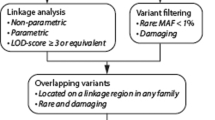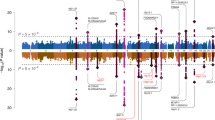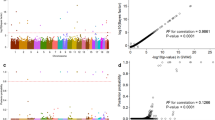Abstract
Stroke is the world's third leading cause of death. One cause of stroke, intracranial aneurysm, affects ∼2% of the population and accounts for 500,000 hemorrhagic strokes annually in mid-life (median age 50), most often resulting in death or severe neurological impairment1. The pathogenesis of intracranial aneurysm is unknown, and because catastrophic hemorrhage is commonly the first sign of disease, early identification is essential. We carried out a multistage genome-wide association study (GWAS) of Finnish, Dutch and Japanese cohorts including over 2,100 intracranial aneurysm cases and 8,000 controls. Genome-wide genotyping of the European cohorts and replication studies in the Japanese cohort identified common SNPs on chromosomes 2q, 8q and 9p that show significant association with intracranial aneurysm with odds ratios 1.24–1.36. The loci on 2q and 8q are new, whereas the 9p locus was previously found to be associated with arterial diseases, including intracranial aneurysm2,3,4,5. Associated SNPs on 8q likely act via SOX17, which is required for formation and maintenance of endothelial cells6,7,8, suggesting a role in development and repair of the vasculature; CDKN2A at 9p may have a similar role9. These findings have implications for the pathophysiology, diagnosis and therapy of intracranial aneurysm.
This is a preview of subscription content, access via your institution
Access options
Subscribe to this journal
Receive 12 print issues and online access
$209.00 per year
only $17.42 per issue
Buy this article
- Purchase on Springer Link
- Instant access to full article PDF
Prices may be subject to local taxes which are calculated during checkout


Similar content being viewed by others
References
Bederson, J.B. et al. Recommendations for the management of patients with unruptured intracranial aneurysms: a Statement for healthcare professionals from the Stroke Council of the American Heart Association. Stroke 31, 2742–2750 (2000).
Wellcome Trust Case Control Consortium. Genome-wide association study of 14,000 cases of seven common diseases and 3,000 shared controls. Nature 447, 661–678 (2007).
McPherson, R. et al. A common allele on chromosome 9 associated with coronary heart disease. Science 316, 1488–1491 (2007).
Helgadottir, A. et al. A common variant on chromosome 9p21 affects the risk of myocardial infarction. Science 316, 1491–1493 (2007).
Helgadottir, A. et al. The same sequence variant on 9p21 associates with myocardial infarction, abdominal aortic aneurysm and intracranial aneurysm. Nat. Genet. 40, 217–224 (2008).
Matsui, T. et al. Redundant roles of Sox17 and Sox18 in postnatal angiogenesis in mice. J. Cell Sci. 119, 3513–3526 (2006).
Sakamoto, Y. et al. Redundant roles of Sox17 and Sox18 in early cardiovascular development of mouse embryos. Biochem. Biophys. Res. Commun. 360, 539–544 (2007).
Kim, I., Saunders, T.L. & Morrison, S.J. Sox17 dependence distinguishes the transcriptional regulation of fetal from adult hematopoietic stem cells. Cell 130, 470–483 (2007).
Janzen, V. et al. Stem-cell ageing modified by the cyclin-dependent kinase inhibitor p16INK4a. Nature 443, 421–426 (2006).
Schievink, W.I., Schaid, D.J., Michels, V.V. & Piepgras, D.G. Familial aneurysmal subarachnoid hemorrhage: a community-based study. J. Neurosurg. 83, 426–429 (1995).
Foroud, T. et al. Genome screen to detect linkage to intracranial aneurysm susceptibility genes: the Familial Intracranial Aneurysm (FIA) study. Stroke 39, 1434–1440 (2008).
Nahed, B.V. et al. Mapping a mendelian form of intracranial aneurysm to 1p34.3-p36.13. Am. J. Hum. Genet. 76, 172–179 (2005).
Ozturk, A.K. et al. Molecular genetic analysis of two large kindreds with intracranial aneurysms demonstrates linkage to 11q24–25 and 14q23–31. Stroke 37, 1021–1027 (2006).
Ruigrok, Y.M. et al. Genomewide linkage in a large Dutch family with intracranial aneurysms: replication of 2 loci for intracranial aneurysms to chromosome 1p36.11-p36.13 and Xp22.2-p22.32. Stroke 39, 1096–1102 (2008).
Gudbjartsson, D.F. et al. Variants conferring risk of atrial fibrillation on chromosome 4q25. Nature 448, 353–357 (2007).
Luca, D. et al. On the use of general control samples for genome-wide association studies: genetic matching highlights causal variants. Am. J. Hum. Genet. 82, 453–463 (2008).
Clayton, D.G. et al. Population structure, differential bias and genomic control in a large-scale, case-control association study. Nat. Genet. 37, 1243–1246 (2005).
Freedman, M.L. et al. Assessing the impact of population stratification on genetic association studies. Nat. Genet. 36, 388–393 (2004).
Shibuya, M. Differential roles of vascular endothelial growth factor receptor-1 and receptor-2 in angiogenesis. J. Biochem. Mol. Biol. 39, 469–478 (2006).
Ziegler, B.L. et al. KDR receptor: a key marker defining hematopoietic stem cells. Science 285, 1553–1558 (1999).
Frazer, K.A. et al. A second generation human haplotype map of over 3.1 million SNPs. Nature 449, 851–861 (2007).
Zeggini, E. et al. Replication of genome-wide association signals in UK samples reveals risk loci for type 2 diabetes. Science 316, 1336–1341 (2007).
Scott, L.J. et al. A genome-wide association study of type 2 diabetes in Finns detects multiple susceptibility variants. Science 316, 1341–1345 (2007).
Saxena, R. et al. Genome-wide association analysis identifies loci for type 2 diabetes and triglyceride levels. Science 316, 1331–1336 (2007).
Pasmant, E. et al. Characterization of a germ-line deletion, including the entire INK4/ARF locus, in a melanoma-neural system tumor family: identification of ANRIL, an antisense noncoding RNA whose expression coclusters with ARF. Cancer Res. 67, 3963–3969 (2007).
Zeggini, E. et al. Meta-analysis of genome-wide association data and large-scale replication identifies additional susceptibility loci for type 2 diabetes. Nat. Genet. 40, 638–645 (2008).
Romeo, S. et al. Population-based resequencing of ANGPTL4 uncovers variations that reduce triglycerides and increase HDL. Nat. Genet. 39, 513–516 (2007).
Ji, W. et al. Rare independent mutations in renal salt handling genes contribute to blood pressure variation. Nat. Genet. 40, 592–599 (2008).
Asahara, T. et al. Isolation of putative progenitor endothelial cells for angiogenesis. Science 275, 964–967 (1997).
Purhonen, S. et al. Bone marrow-derived circulating endothelial precursors do not contribute to vascular endothelium and are not needed for tumor growth. Proc. Natl. Acad. Sci. USA 105, 6620–6625 (2008).
Acknowledgements
We are grateful to the participants who made this study possible. We thank A. Chamberlain, O. Törnwall, M. Alalahti, K. Helin, S. Malin and J. Budzinack for their technical help. This study was supported by the Yale Center for Human Genetics and Genomics and the Yale Program on Neurogenetics, the US National Institutes of Health grants R01NS057756 (M.G.) and U24 NS051869 (S.M.) and the Howard Hughes Medical Institute (R.P.L.). C.E.M. and M.W.S. are supported by a gift from the Lawrence Family and Y.M.R. by the Dr E. Dekker program of The Netherlands Heart Foundation (2005T014). K.Y. and I.I. were supported by the Core Research for Evolutional Science and Technology, Japan Science and Technology Corporation.
Author information
Authors and Affiliations
Contributions
Cohort ascertainment, characterization and DNA preparation: M.N., E.G., A.L., A.P., J.Ö. and J.H. (Helsinki); M.v.u.z.F., A.R., T.K., J.R., A.P. and J.E.J. (Kuopio); Y.M.R., L.H.v.d.B., C.W. and G.J.E.R. (Utrecht); C.M.v.D. and M.M.B.B. (Rotterdam) and A.T., A.H., H.K. and I.I. (Japan). Genotyping: K.B., Y.B., L.K., Z.A., S.R., R.P.L., M.G. and S.M. Study design and analysis plan: R.P.L. and M.G. Data management and informatics: C.E.M., K.B., M.W.S. and M.G. Statistical analysis: K.Y., K.B., I.I., M.C., R.P.L. and M.G. Writing team: K.B., K.Y., M.W.S., M.G. and R.P.L.
Corresponding authors
Supplementary information
Supplementary Text and Figures
Supplementary Methods, Supplementary Tables 1–6 and Supplementary Figure 1 (PDF 374 kb)
Rights and permissions
About this article
Cite this article
Bilguvar, K., Yasuno, K., Niemelä, M. et al. Susceptibility loci for intracranial aneurysm in European and Japanese populations. Nat Genet 40, 1472–1477 (2008). https://doi.org/10.1038/ng.240
Received:
Accepted:
Published:
Issue Date:
DOI: https://doi.org/10.1038/ng.240
This article is cited by
-
Sox17 protects human brain microvascular endothelial cells from AngII-induced injury by regulating autophagy and apoptosis
Molecular and Cellular Biochemistry (2023)
-
Understanding the pathogenesis of brain arteriovenous malformation: genetic variations, epigenetics, signaling pathways, and immune inflammation
Human Genetics (2023)
-
The quest to unravel the complex genomics of intracranial aneurysms
Nature Cardiovascular Research (2022)
-
Epigenetic landscapes of intracranial aneurysm risk haplotypes implicate enhancer function of endothelial cells and fibroblasts in dysregulated gene expression
BMC Medical Genomics (2021)
-
Co-existing of craniofacial fibrous dysplasia and cerebrovascular diseases: a series of 22 cases and review of the literature
Orphanet Journal of Rare Diseases (2021)



